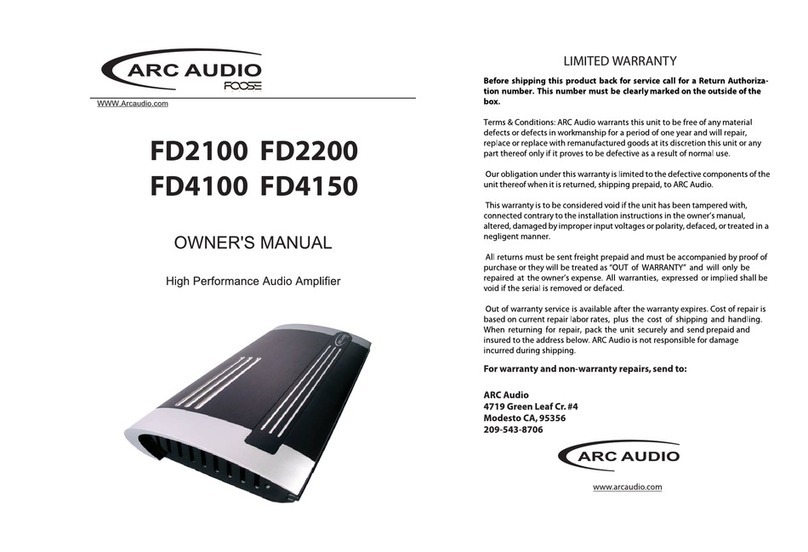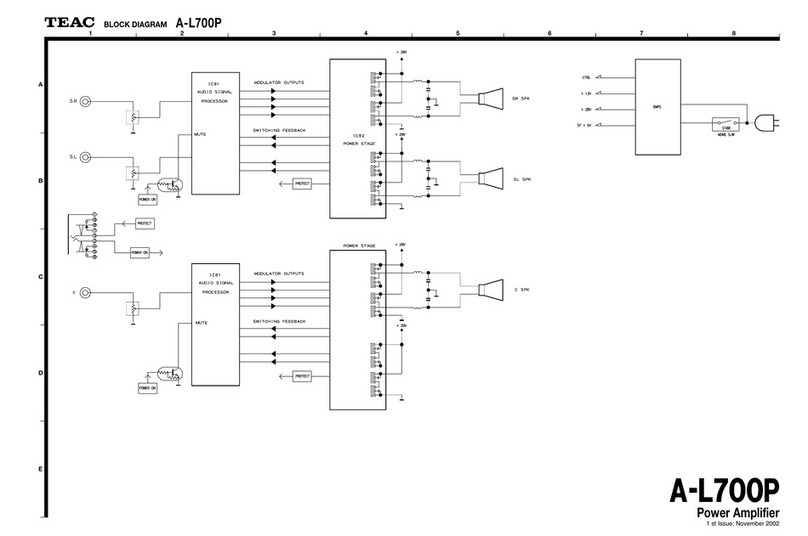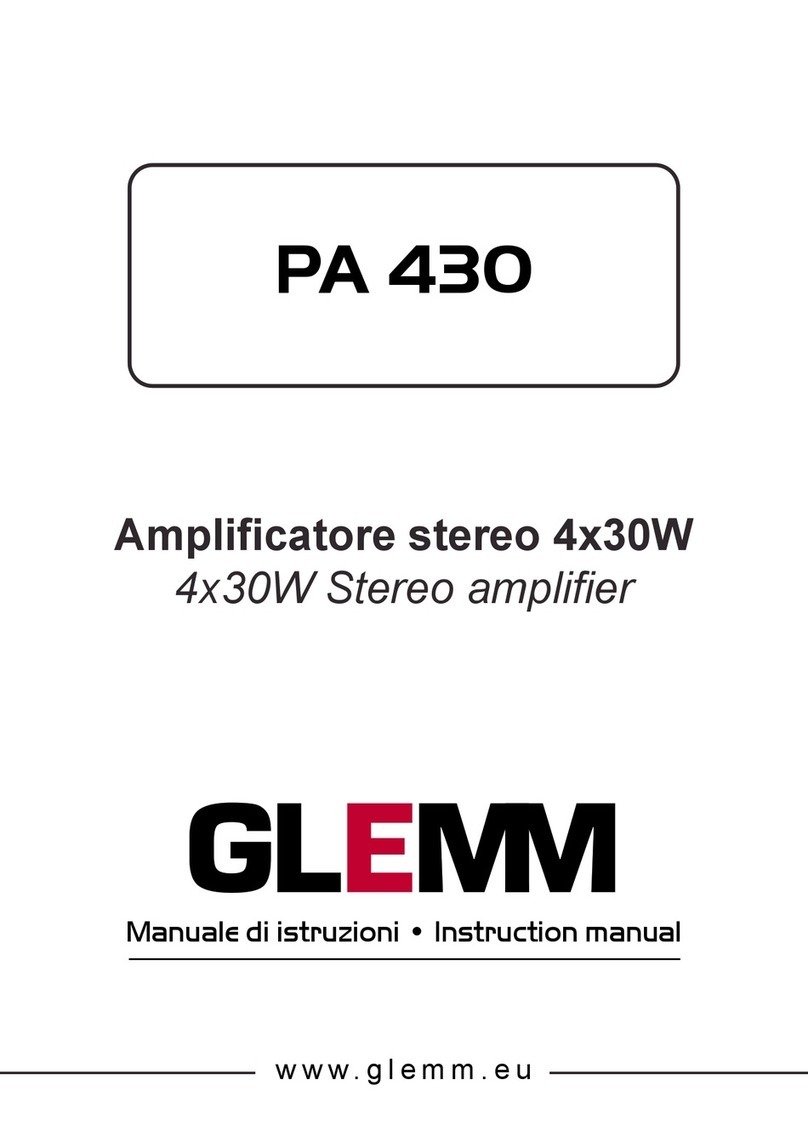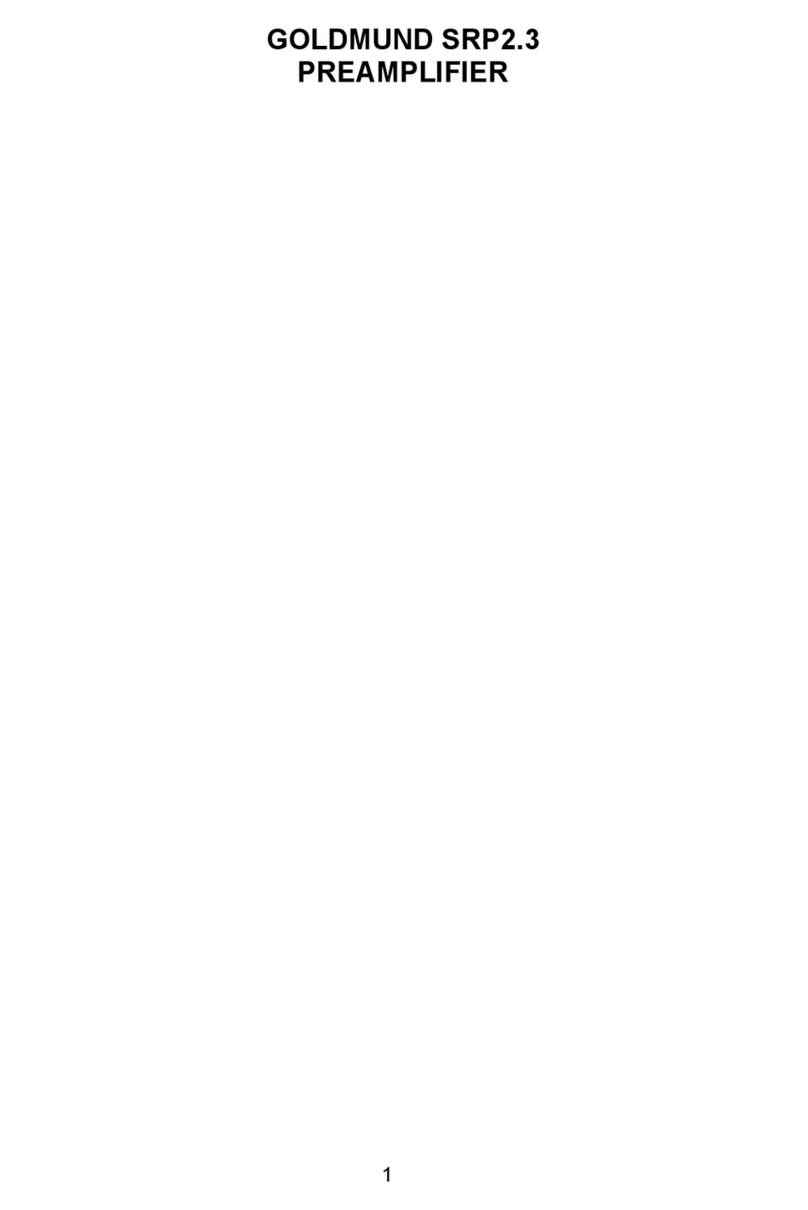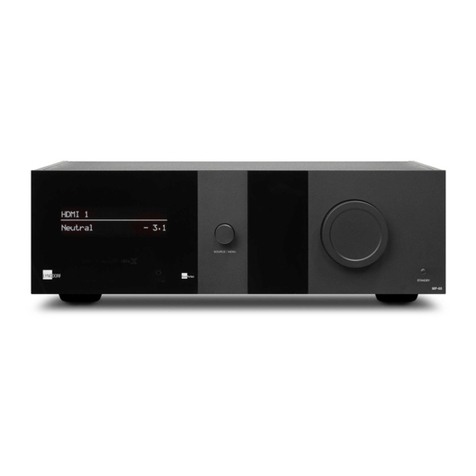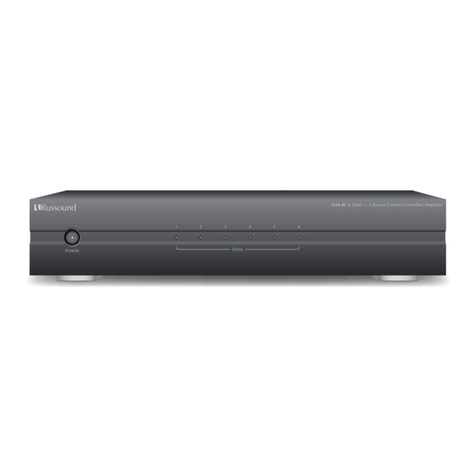International Tapetronics Corporation 770 Series User manual

www.SteamPoweredRadio.Com
TECHNICAL
MANUAL
(890-0025-000)
770
SERIES
REEL-TO-REEL
RECORDING
AMPLIFIER
Th
is
Technical Manual
is
intended
to
be u
se
d
as
a supplement
to
, and
in
conjunction with ITC
Technical Manual
890
-
0024
-
000
,
for
the
770
SeriesReel-
to
-Reel Reproducer.
1nreRnATIOnAL
TAPETROn1cs
CORPORATIOn
24
25
SOU
TH
MAIN
STREET •
BLOO
MINGTON,
IL
LIN
OIS
617
01
©
Cop
y
right
1981
lnt
e
rnatlonal
Tap
etr
onics
Corp
oration.
Madeunder
one
or
more
of
the following patents:
3.800,
3233,
801,
0433.801.3293,833.
925
3.865,719
otherpatentspending

www.SteamPoweredRadio.Com
0381OM
PREFACE
THEITC INSTRUCTION MANUAL
International Tapetronics Corporation Manuals are
written with the intent
of
assisting the reader-user toward
a better understanding
of
ITC
equipment. Most instruc-
tion manuals are seldom read except
at
the time
of
crisis
when equipment malfunction is suspected. When this
happens. the manual is usuaJly missing,
or
at
best, diffi-
cult
to
locate. PLEASE FIND A
CONVENIENT
SPOT
TO
KEEP
THIS
MANUAL.
We
at
ITC
have tried
lo
produce a useable manual.
But,
being human. we are subject
lo
the frailties
of
be-
havior, Therefore, should you discover any errors
or
omissions.
or
should you wish
to
contribute any recom-
mendations, please send us
your
comments. We will be
mostappreciative.

www.SteamPoweredRadio.Com
TABLE
OF
CONTENTS
PREFACE
..........
..
...
..
..
.
.......
.
...
..
........
-
...................
i
TABLE
OF
CONTENTS
...
. .
..
..
.
....
..
.......................
,
......
iii
ILLUSTRATIONS. .
..................
.
....
. , .,. ,,
..
,
.....
,
..
,
......
,
..
v
SECTION I.
INTRODUCTION
A.
General
...........
. . . . .
..
••
..............
,
................
•
...
l ·l
B.
Reco
r
der
Electronics . . . . . . • . . . . . . . . . . • . .. . . . . . . . . . . . . . . . . . . . . . . .
..
1-1
C.
HeadAssembly
......
•
.............
•
....
,.,,
••
. • . ,
.,
.......
1-1
D. Specifications . . . . . . . . . . . • . . . . . . . . . . . . . . . . . . . . . . . . • . . . . . . . . . . . . • . .l •l
E. Warranty. . . .
.•
. . •
.••
•.
.•
••...
.•
...
••
...
•
.................•..
1-2
SECTION
II
. INSTALLATION
A. Unpacking
and
Handling
.................................
.
..........
2-1
8 . Installation in Rack
or
Console
.............
•
...
•
....
,
......
••
..
.••
..
2-1
C.
Connecting
Audio Lines .
..........
.
..........•
.
......
.
....
•
...
,
.....
2-1
D.
Remote
Control
Connections
. . • , •. •
...
• , •
..
. , • , . . . •. . . . • . . .
.•
. .
..
,2· l
E. Preliminary Tests
.............................
.
....................
2-2
SECTION
Ill.
UNIT
OPERATION INSTRUCTIONS
A. Controls
and
Indicators . . . . . . . . . . . . . . . . . . . . . . _
...
•
.....
••
...
,
.•.
....
3-1
1.
Record
Set
Switch
2 .
Channel
Select
and
P.R.S . (Play-
RecordSynchr
onization)
3. MeterSelect
Switches
4. LED Indicators
B. Recording
..........
..•
,
.....
,
.....
3-2
SECTION
JV
. SETUP, ALIGNMENT,
AND
CALIBRATION
A.
General
..
. . . . . . . . . . . . . . . . . . . . . . . . . . . . . . . . . . . . . . . . . . .
.....
•
.......
4-1
B. Playback Meter Calibration
.......
..
..
, . . . . . . . . . . . • . . . • . . . . . . . . . . . . 4-1
C. Record
Head
Alignment
...
_. . . . . •. . . . . . . . . . . . • . . . • .
...
•
.........
4-1
D. Bias
Trap
Adjustment
....
.
.....................
.
...........
•
........
4-2
E. Bias Adjustment
....
. . . . .
.....
.
...
•
...
•
........
.
•.
.
...
. ,
..
, . ,
....
4-2
F. Recording Amplifier Equalization . . . . . . . . . . . . . . . . . . . . . . . . . . . . . . . . . . • . .
4-3
G. Record Line MeterCalibration (Rec) . . . .
..................
•.
....
..
...
4-3
H.
Two
Spe
ed Re
co
rdingAmplifier Level Calibr
ation
.........
•
...
••
....•
• . . . 4-4
I.
P.R.S . Amplifier Bias
Trap
...........
, . . . .
..
.
.....
. - . . . .
....
4-4
J . Bias Meter Calibration . . . . . . . . . . . . . . • .. • . , . . . . .
....
.
..........
•
....
4-4
K P.R.S. Amplifier Meter Calibration
........•
.
...•.....
_..........
.
....
4-4
SECTION V.
ROUTIN
E
MAIN
TENANCE
A.
General
. . . . . . . . . . . . . . . . . . . . . . . .
...
•
....
,• . . .
.................
5-1
8 .
Maintenance
Tools
and
Aids
......
.
...............•..........••
•
.....
5-2
C.
Spare
Part
s
.....
.
..........
,
...
• , . . . . .
.....
•
..
•
...................
5-2
SECTION
VI
. THEORY
OF
OPERATION
AND
DESIGN
A.
General
. .
...............................................
, • . . . . 6·1
B.
Recorder
Control Logic
...................
.
.....
..
...........
•
...
,
..
6-1
C.
BlasOscillator
...........
•
.....
, • ,
...
•
...
,
.....
•
..
• , , .
....
,
.........
6-1
D. Meter Amplifiers
.........
.
....
.
.....................................
6-1
E. Program Recording Amplifier
.,
..
, . . . . . . . . .
....
,, , , . , •
...
,
...........
6-2
F. Play-
Record
Synchronizing (P.
R.S
.) Amplifier
...
•
....•
•
....
••
.........
6-2

www.SteamPoweredRadio.Com
SECTION
VU
.
ELECTRICAL
DRAWINGS AND PARTS
LIST
A. Record
and
MeterAmplifier
Componen
t Loading
and
Overlay
..
..
..
.....
7-1
8.
Record
and
Meter Amplifier Parts List . . . . . . . . . . . . .
..
.
....
. .
..
. . 7-2
C. Bias Oscillator
and
RecorderControlCo
mponent
Loading
and
Overlay ,
...
7-5
D. Blas Oscillator
and
RecorderControlParts
Ust
...
. . . . . . . . . . . . 7-6
E.
L.
E.D. Indicator
Card
Component
Loading
and
Ov
erlay . . . . • .
...
. , , . 7•8
F. Mother
Board
Component
Loading
and
Overlay
...
...
.
...
.
•...
. . .
...
7-9
G. Mother
Board
PartsList . . . . . . . . . . . . . . . . . . . . . . . . . . . • . . • , 7-
10
H. R
ecord
Amplifier Schematic
...
..
.
..
...
..
.....
,.
,
....
, . .
..
. 7•11
iv

www.SteamPoweredRadio.Com
Figure
2-1
Figure 2-2
Figure 2-3
Figure
2-4
Figure
3-1
Figure4
-1
Figure 4-2
Figure 4-3
thru 4-6
Figure 4-7
Flgure4-8
Figure 5-1
Figure 7-1
Figure 7-5
Figure 7-8
Figure 7-9
Figure7-
11
ILLUSTRATIONS
P
age
Record Amplifier
Input
Connections . . . . . . . . . . . . . • .. . . 2-1
Remote
Control
Connections . . . . . .. •. , • , • , , , . •.• . 2-2
CableInterconnect Diagram . . •. . . .. . . . . . . • . . . .. . . . . . . 2-2
RearPanel Connectors
...........
..
,
...•
, . . . . •• . . . . . 2-3
Front Panel Controls . . . . . . . . . . . . . . . . . . . . . . . . • . . . •. .3-1
MeterCalibration Adjustment Points . .. •. . . .• •
•.
, .,
..
4-1
Head AdjustmentPoints
...........
.
..
.
.....
.••...•..
..
4-2
Oscilloscope Phase Patterns
.....
.
....
..
..
..
.
.•...•
Bias AdjustmentPoints . . . . . . . . . . . .. . . . . . .• . . . .
Equalization and LevelAdjustmentPoints
.......
.•..•
MaintenanceSchedule. .
...........
.
........
.....
.
Record andMeterAmplifier
Component
Loading
. .
4-2
...
4-3
,. 4-3
....
5-1
andOverlay
....
.
....
............
..
..
...
.........
7-1
Blas Oscillatorand RecorderControl
Component
Loading
andOverlay . .
.................
.
..........
.
........
7-5
L.E.D
. IndicatorCard
Component
Loadingand Overlay
...
7-8
Mother
Board
Component
Loadingand Overlay . ,. . . . . . 7-9
Record AmplifierSchematic . . .. . . . .. . . . . .
...
.••...
7-11
V

www.SteamPoweredRadio.Com
SECTION I - INTRODUCTION
A. GENERAL
The
770
Se
ries R
ecorde
r is
designed
for the
broad
-
caster. It
is
idea
ll
y suited for
use
as
a utility
recorder
automation syst
em.
The
770
Seriesis:
• deslgned
to
meet
or
exceed
the
N
AB
(National
Association of Br
oadcaste
r
s)
standards
for reel-
to
•
reel
tape
recorders:
• available
in
a variety of
con
figurationsincluding,
.
one
or
two track,
mono
or
stereo
capabilities
and
.
tap
e
speeds
of
3-3/4
to
7-1/2
and
7-1/ 2 to
15
IPS:
•
designed
with a
heavy
1/ 2 inch
(12.700
mm) thick
aluminum
to
ol
plate
deck
for stability:
• designed with a
unique
, h
ig
h quality, professlonal
head
assembly;
• utilizes individual
torque
motors for
supply
and
take
up
reel handling,and a D.C.
servo
ca
pstan
mot
or
for
tape
drive;
and
•
designed
for simp
li
city
and
se
rviceability ofelectronic
c
omponents
.
The
770
Series
Record
Amplifier
and
Transp
ort
ieatures:
• low
maintenance.
positive action differential disc
brakes:
• strong, cast stainless
st
eel turntables;
• long
li
fe
co
ntrol switch
es
and
an
ingenious swllch
s
upp
ort:
• multispeed D
.C
.
servo
caps
t
an
motor
;
• im
proved
playback
head
.
All
770's
ar
e factory wired
to
accep
t the
ITC
sub-
audible
25
Hz detector
module
assembly. which
is
avail-
able
as
an
option.
This plug-in
module
is
designed
to
provide a variety of
opera
ling
mode
s.
8. RECORDER ELECTRONICS
T
he
electronics of the
770
Series Recording
Amp
lifier
provides simplicity
and
se
rviceability.
Th
e
mother
/
daug
hter
board
and
ribb
on
cable
connectors
elimi
nat
e
bulky wiring.
All
maintenance
adjust
m
ents
are
eit
h
er
accessible
at
the
fr
on
t
panel
or
directly
above
t
he
printed
ci
rcuit
ca
rds.
Front
pane
l
meter
switching allows the o
perator
to
monitor
the
playback
ou
tputs
.
the
recorder
inputs, Pl
ay
-
Re
co
rd
Synchronizi
ng
,
and
program
re
co
rding bias. T
he
meter m
onito
ring
mode
m
ay
be
au
tomatically switch
ed
to
pr
ogram
play
when
In
th
e play
mode
ev
en
though
the
r
ecorde
r
inpu
t monitor switch
ma
y
be
selected.
An input
fr
om
the
meter
am
plifier
is
brought
ou
t
to
the
front panel of the
recorder
. H
eadphones
may
be
plugged
in
al
th
is
point for
moni
to
ri
ng
purp
oses. An additional
o
utpu
t is brought out
to th
e rear
panel
or
the
re
co
rder
which
may
be
used
for
the
same
purp
ose.
0381DM
T
he
stereo
model
is
equipped
wi
th the Play-Record
Synch
ronizing feature. P.R.S. allows the
recor
ding of
information
on
one
track in
sync
hronizati
on
with material
previously
recorded
on
the o
th
er
track.
The
recorder
electronics
may
be
mounted
directly
below
the
reprodu
ce
transp
ort
or
in
a
remote
locati
on
up
to
42
inches
(1066
.
80
mm)
away
. A roll-
around
console
is
available as a sp
ec
ial
option
.
C.
HEAD
ASSEMBLV
T
he
ITC
770
Se
ri
es
recorder
is
equip
ped
With
a
unique, high quality professional
head
assembly
The
head
is
mounted
in a bracket designed to allow total
azimuth, height
and
zenith adjust
ments
.
Three
plug
-In
heads
are
used in conjunction with independenUy
mounted
tape
guides.
Th
e
head
assembly
Is
eq
uipped
with a solenoid
actuated
tape
lifter. EJectr!cal
co
nnec-
tions to the h
ead
assembly. l
ocated
on
the
transport
deck
, are
ma
de
thro
ugh
special
in
t
erconnec
t cables.
D. SPECIFICATIONS
Power
:
(includes
reprodu
ce
deck
and
recorde
r electronics)
10
5-
12
5 volt
s.
AC,
60
Hz
, 165watts max.
Recorder
Sourc
e
Impedance
:
600o
hms
Re
c
order
Jnput
Impedanc
e:
5000
oh
ms
balanced
(15 K ohm bridging
str;:1p
-
pable)
Input
Lev
el:
-
22
dBm
(.061 volts)
m1n1mum
to record
1)
1 ''
O''
refer
ence
level (1
85
nWb
/ m flux level) + 8
dBm
(1.96volts) maximum
Distortion
(Record
to
Play):
Using 4
00
Hz
ton
e r
eco
rd
ed
at
NAB
standard
referen
ce
level (•) with r
eproduce
amplifier
ad-
justed for O dBM
output
,
and
meas
uri
ng
on
a
distortion. analyzer with a
700
H
z.
to 20 kHz
band
-
width
15
JP
S 1.
2%
7.5 IPS 1.5%
3.
75
lPS 2.
0%
NOTE!
All
distortion r
eadings
are
t
ape
-limited.
Amplifi
er Headroom:
Maximum amplifier
he
ad
r
oom
above
reference
level (1
85
n
Wb
/ m) using frequencies of l kHz
and
10
kHz.
Tap
e
Speed
15
!PS
7.5
JP
S
3.
75
I
PS
1 kHz
+23dB
+2
3d
B
+23dB
IO
kHz
+
23d8
+
19dB
+
12
dB
1- 1

www.SteamPoweredRadio.Com
1-2
Crosstalk:
Better than
50
dB
at 1 kHz
Fre
qu
e
nc
yResponse:
3-3/ 4 ips (+
2d8-3.5d8)
25
to
35
Hz;
±2d8
35 to
8,
000
Hz
.
7-1/ 2 ips (+
2d8
-
3d8)
25 to
35
Hz
; ±
2d8
35
to
15.000
Hz.
15
ips
(+2dB
-3.SdB) 25
to
35
Hz
;
±2d8
35 to
18
,000 Hz.
Equalization
:
NAB withadjustments
for
highfrequencycontrol
Hea
dphone
Output
:
8 ohms
or
greater
Meter
Amplifier
Monit
or:
600
ohms
(available at rearchassis)
Remote
Control
:
Record
se
t switch and recordindicator lamp
External
Connectors:
Latching and
phono
types Mating plugs and
sockets furnished.
H
ea
d
and
Track
Configuration:
F1JII
Tr
ack monophonic
Half
Track monophonic
Hal
f Tra
ck
stereophonic
(2
channel)
Qua
rter
Track
stereophonic(2 channel)
Metering:
T
aut
-band moveme
nt
with
"A"
scale. Meter switch
selection for metering the following:
Normal
line recording level, P.R.S. bias and
pro
•
gram play, (Meter sensitivity may be
ca
librat
ed
for
0
to
+ 18
dBm
o
utput
level.)
Erase De
pth
:
Below Noise Level
Ambi
e
nt
Op
e
rat
i
on
Te
mperature
:
55°
C - 131
°F
maximum
Mounting
:
Rack
mo
unt
ing. (Console cabinet
op
tional.)
Dimen
sions:
19 inch
es
wide
(482,
60
mm)
9 inches deep
(228.60
mm)
3-1/2
inches high
(88
.
90
mm)
Weight
:
15
pounds
(6,
805
kg)
unpacked
(•) Measureme
nt
s made using
3M
type
206
or
equivalent tape
E.
WARRANTY
Seller warrants to purchaser that the equipment sold
Is
free
of
defects
of
workmanship
or
material and conforms
to the specifications refe
rr
ed to set
out
herein. This
war
r
anty
extending
only
to
the original useris
For
a period
of
two
years from date
of
shipmentand
no
claim sha
ll
be
maintained hereunderunless written notice
is
received by
Seller within thirty days after discovery of thefacts giving
rise to the claim. Thesole
or
exclusive liability of Seller for
breach
of
warranty shall be to refund
th
e purchase pri
ce
of
the item sold,
or
at its option, to replace
or
repair the
item
or
part concerned
FOB
its
fac
tory,
or
such other
place
as
it
may designate. Seller's liability shall arise only
if
pu
rchaser causes the defective part
or
item to be
delivered
to
Seller f
or
inspection
upon
Seller'srequest at
pu
rchaser's expense. Items manufactured by persons
other
than Seller shall bear the warranty given by such
otherpersons and
no
other warranty. This warranty shall
not
be effective
if
the alleged defect is
due
to
maltreat-
ment, exposure. excessive moisture. or any other
use
of
equipment other than the use for which the manu-
facturer prescribed.
0381DM

www.SteamPoweredRadio.Com
SECTION
II -INSTALLATION
A. UNPACKING
AND
HANDLING
Carefully
remove
the
770
Series Recording Amplifier
from
the
shippingcarton
and
inspect1he unit
for
damage
.
All
packing material must
be
retained
if
a claim for
shipping
damages
is to
be
flied.
and
therefore, should
be
kept
on
hand
until installation
has
been
c
ompleted
in
case
concealed
damage
is
discovered_
If
shipping
damage
Is
found,
contact
ITC for assistance in claims. It
is
sug
-
gested
that
packing material
be
retained for
any
future
use
.
B. INSTALLATION
IN
RACKOR CONSOLE
All
770
Serles
Re
cording Amplifier modules
are
supplied in a 19" (482.
60
mm)
rack
mounting configura-
tion. If
an
excessive
amount
of
heat
Is
present in the rack
in which
the
machine
is
to
be
mounted,
be
certain
to
supply
adequate
ventilation for
proper
operation of this
unit. Ideally,
the
recording amplifier module should
be
mounted
directly
under
the
770
SerlesPlayback Deck, so
that
heat
rising from
the
torque
motors
and
other
heat
producing
components
will
not
contribute
any
heat
lo
the
recording electronics.
All
consoles for I
TC
reel
to
reel recorders
and
re
-
producers
are
shipped
separately
and
, therefore,
will
require mountingfollowing shipments.
After removing
the
console from
the
packing material,
install the four casters
in
the
bottom
of
the
console legs.
Set
the console upright
and
rotate
the
transport deck
table
to
its vertical position by pressing
the
release button
located
on
the
front
upper
right
hand
side
of
the
console
cabinet. This
will
allow
the
table
to
rotate
and
lock
in
various planes. With
the
aid of
another
person
, carefully
slide the transport mechanism into
the
mounting
area
.
NOTE:
When
handling
the
transport,
be
careful not.
to
damage
Items
such
as
motors
and
brakes_
After
the
transportis properly located, carefully
rotate
the
table back
to
its horizontal position.
Secure
the
assembly
wi
th
the
enclosed rack mounting screws
and
washers.
Included with
the
co
nsole is a 1-3/
4'
'
(44.45
mm) filler
panel
. This
panel
must
be
mounted
toward
the
top
end
of
the
transport deck assembly in
order
to
fill
the
vacant
space
.
The
recorder chassis is
mounted
by sliding
it
into
position from
the
front of the
console
and
then securing ii
with
the
enclosed hardware.
C. CONNECTING
AUDIO
LINES
A 6-pln
socket
is provided with
each
770
Series
Recording Amplifier for
the
audio
input connections.
R
efer
to
Figure 2-1 for
the
connection
of
this
socket
Observe
the
proper
phase
relationship
on
two channel
units.
0381OM
A
600
ohm
unbalanced
output
of
the
meter
amplifier(s) is provided
on
the
rear
of
the recording
amplifier chassis.
J703
and
J704
are
standard
phono
type
connector
sockets.
It
is
recommended
that
two
conductor shielded cables
be
used
for
recorder inputconnections. Single
conductor
shielded cable may
be
used for
the
meter
amplifier output
connections.
C
HANN
EL +
I
C
HANN
EL
+
2
-
-----
-
" '
FIGURE2
-1
P l
RE
C.
ORO
£~
t
NP
tJ
T
CQNf'IE
C.
T
IO
NS
ln
order
to
provide
proper
monitoting
and
control
facilities. several interconnect cables
are
used
to
connect
the recording amplifier chassis
and
the reproducer
deck
.
Th
e first cablecontains two 6-pin plugs.
one
at
each
end.
One
end
connects
to
J
102
locat
ed
on
the
reproducer
deck.
the
other
end
plugs into
connector
J4
located
on
the
rear
panel
of the recording amplifier chassis.
The
playback
audio
output
connections must now
be
con-
nected
to
output
connector
J3
which
is
also located
on
the back of the
reco
rdingamplifier.
The
second
interconnect cable
has
15
-pin plugs
located
at
each
end
.
One
end
plugs into connector
JlOl
,
which
Is
located
on
the reproducer deck,
the
other
end
plugs Into
connector
J2,
which
Is
located
on
the
recording amplifier.
In addition
to
the two previously
desc
ribed inter-
connect
cables, there
are
two
head
cables (4 cables in
stereo
units) which must
be
connected between
the
appropriate
head
connectors
on
the
recording amplifier
and
the
reproducer
deck. T
hese
cables are individually
identified
and
must
be
connected
lo their matching
sockets
and
plugs.
If
not
connected properly, bias
wUI
need
to
be
recalibrated.
D.REMOTE CONTROLCONNECTIONS
Remote
control functions
are
provided
through
connector
JlOl
for START.
STOP
, FAST REWIND,
FASTFORWARD,
and
associated lampcircuits (24 volt,
40
ma
.).
All
functions are direct, pin for pin connections.
The
control functions, record
se
t.
and
record lamp
are
shown
in Figure
2-2.
Ifdesired.
the
RECORD
SET
switch
may
be
wired from pin
17
to
pin 1 rather than pin 17 to
2·1

www.SteamPoweredRadio.Com
•
pin
11
as
shown
on
the
remote
schematic.
When
wired in
this
manner
,
RECORD
SET
is
active both prior to
and
during the
START
• RUN
mode
of
operat
ion.
The
remote
switch
must
be
a
momentary
contact, normally
open
single
pole
type
.
Rem
ote
indication
of
the
RECORD
SET
function
is
obtained by connecting
the
RECORD
SET
LAMP
between
pin
16
and
pin 1.
The
circuit
is
designed
to
operate
a
24V.
40
ma
. incan-
descent
bulb.
2-2
RECOROER
JI
11
RECORO
SE,
RECORO
SE:i
PRtsn
Strol\E
SlART
PRESET AND
SET
DURING
S1AfH
F
IGURE2-2
E. PRELIMI
NARY
TESTS
Check
all motors
and
rotating parts before operating -
the
770
Series
machine
.
They
sho
uld rotate freely.
Be
ce
rtain
the
P.
C.
cards, relays,
and
ribb
on
cable con-
nectors
are
properly
seated.
Beforeplugging
in
the
power
cord insure th
at
the
line frequency
and
voltage
are
correct.
117
volts ±
10%
,
60
Hz.
The
ready
indicator LED should illuminate
if
the
tape
has
been
properly
loaded
onto
the
deck
. After loading
the tape press either
or
both
channel
select switches.
(Only
one
switch
if
the
machine
is
mono
.)
When
pressed.
the record set LED(s) indicator
shou
ld
illuminate.
-11u.o,.o,.
10
~\.,IIYIACII.
C0
111W
Oi,.
..-.t(,-(QIIIJ1t(C'l10
'11
0381OM

www.SteamPoweredRadio.Com
0 [u][u]
0381OM
PLAYBA
CK
AUDIO
INTERCONNECT
RECORDER
AUDIO
INTERCO
NN
ECT
TO
DECK
INPUTS
OU
TPUTS
CABLE
®
Jl
J4
CHANNEL
Cl<A
HH[I. ©
• I
@)@)
@)@
t:
flASE ttt:COflO E.IIASt "°£CORO
RECORD
AND
ER
ASE
HEAD
I
NTERCONNECTS
FlGU
R
E2
-4
JI
coo
(?)
oc:10
aoo
□ oo
ooo
o
□□
®
□□
O
ooa
o □□
®
oo
□
□□□
J2
RE
M
OTE
CONTROL
CO
N
NECTIONS
PRS
OUTPUT
@@
CH I CH t
PLAY-RECORD-SYNC
OUTPUTS
0
I
MET
ER
AMPI..I
FIER
OUTPUTS)
2·3

www.SteamPoweredRadio.Com
SECTION
Ill
-OPERATING INSTRUCTIONS
A. C
ON
T
ROLS
AND
INDICATOR
S
Six switches are present on the stereo
sys
tem and five
onthe m
ono
.
1. R
ecor
d Set
Switch
T
he
record switch may
be
operated in two diffetent
configurations. The configuration depends upon
the strappableoption selected.
• If points A and B on the bias oscillator
and
recorder control PC board are strapped together.
the record
se
t switch will
be
active only during the
START-
RU
N mode.
•
If
points C and D are strapped together. the
RECORD SET switch will be active in either the
READY mode
or
during the
ST
ART
•
RUN
mode
of operation.
The
RECORD SET switch
is
active only when
the co
rr
ect
CH
A
NNEL
SELECT swltch(es) is de-
pressed This provides a
"SAFE"
condition where-
by pre-recorded material may
not
be
erased. On
a
two
channel unit the individual CH
ANNEL
SELECT switch
es
provide the Play-Record Syn
chronizing
as
ano
therbuilt-in feature.
2. Cha
nnel
Se
le
ct
and
P.R
.S
.
(Pl
ay-R
ecor
d-
Synchronlzatlon)
The P.R.S. feat
ur
e
is
standard on all
two
chan-
nel 770 reel to reel recording amplifiers. The P.R.S.
circuitry allows the recording
of
information on
one
track while monitoringmaterial previouslyrecorded
on t
he
other track.
The
following conditions must
exist
for
prope
r operation
of
P.R.S.:
a)
The METER SELECT switch must
be
in record
(REC) position;
b)
Either Channel 1
or
Channel 2
SELECT
switch
rnust
be
depressed; and (
If
both
CHANNEL
HE
ADPHONE OUTP
UT
(M
ONITORS
MCTE:R AM
PLIFIER)
RECORD
SE
T
SW
ITCH
SELECT
switches are depressed simultaneously
P.R.S.
is
nonfunctional.)
c)
The
recorder must
be
set to the RECORD mode
and moving
ta
pe,
If the operator is recording on Channel 1, the
Channel 2 met
er
circuit will monitor program
material which
has
been previously recorded on
Channel 2. The monitoring Is through the record-
ing head, and therefore
is
in perfect synchroniza-
tion
with
thematerial being recorded on Channel 1.
The output
of
the P.R.S. amplifier may
be
moni-
tored through the front panel headphone output
and/
or
the rear c
hassis
meter mode output con-
nector.
At
all other times. the meter switching will
function norrnally,
3. Meter Sel
ec
t
Swi
t
ch
es
a)
Play
With this switch depressed, the merer circuitry
will monitor t
he
output
of
the reproduce amplifier
at
all times.
b)
Bias
With this switch depressed, program bias will
be
continuously monitored during the
re
cording mode.
There
will
be
no
meter indication during the
play
mode
.
c)
Record (REC)
Thisswitch performs three baskfunctions
1)
Monitors the
input
of the recorder
if
in
the
RECORD
SE
T mode,
2)
Monitors the P.R S. output
as
previously de-
scribed; and
3) Automatically switches to and monitors the
re
-
producer output
if
not in the RECORD SET
mode
.
CHANN
EL
MET
ER
CHANNEL
2
M
ETE
R
INPUT L
EVEL
CH
AN
N
ELi
INPUT
LEVEL
CHANNEL 2 CHANN
EL
SELEC
T SW
ITC
HE
S
0
0
0381OM
ANO IN
DICATORS
RECORDER PROGR
AM
INPUT
LEVEL
B
IAS
PROGRAM
PLAYBACK
ME
T
ER
SELECT
SWI
TCHES
FIGURE3
·1
0
0
3-1

www.SteamPoweredRadio.Com
4.
LED
Indicators
The
red LED indicators
will
be
illuminated only
when a
channel
has
been
selected
and
t
he
RE-
CO
RD
SET
switch
depressed
as
previously
de
-
scribed.
8.
RECORDING
To
record a reel of tape:
1. L
oad
and
thread a reel of
tape
;
2. Depress the
app
r
opriate
channel
select switches;
3 . Press
the
RECORD
SET
switch
and
obse
r
ve
that
the
record LED Uluminates, indicating
the
machine is
in
the
RECORD
mode
.
4. Press the
START
switch.
The
RECORDswitch
can
be
pressed after
the
ST
ART switch.
if
so
wired.
5. Adjust recording level
on
t
he
VU
meters
so
that
major
peaks
do
not
exceed
the
O VU point,
but
should
remain
as
close
to
the
ZE
RO indication
as
poss
ibl
e.
3-
2.
0381OM

www.SteamPoweredRadio.Com
SECTION
IV.
SETUP,
ALIGNMENT,
AND
CALIBRATION
A. GENERAL
All
ITC
recording amplifiers and record/reproducers
are fully tested and adjusted
at
the factory for
optimum
performance and normally require
no
further adjust-
ments
prior
to
installation.
However
,
due
to
normal
variations
in
tape types and oxide formations, thefactory
adjustment
of
theRecord Amplifier
may
be"tweaked" for
optimum
pe
rforman
ce
with thetape brand you are using
As with any tape rec
orde
r,
op
timum performance is
achieved
only
when the Record
Ampl
ifier
is
carefully
adjusted to a specific tape type and brand. Customers
using several types and brands
of
tape should expect
varlations
in
performance due
to
different oxides, and
should be aware that performance characteristi
cs
of
the
770
System can and
may
vary depending
on
the tape
used. Best consistent performance is achieved when a
single tape type
is
used, and the Record Amplifier
is
adjusted
for
thatparticular tape.
Adjustments
of
the recording amplifier shou
ld
not
be
undertaken unless a defined lack of performance exists
and
the reproducer has been carefully tested and found
not
to
be a contributing factor. The adjustments described
In this section
of
th
e Technical Manual should be fol-
lowed
in
the sequence presented to achieve a fully and
accurately aligned recorder. Access to adjustments points
is
by
removal
of
the front switch panel dress plate and top
stainless steel chassis plate.
Note
that
many
adjustments
are dependent
upon
and interact
di
rectly with each
other. Therefore. when one specific adjustment is
changed, it
may
be necessary to perform through the
entire adjustmentprocedures
for
therecorder.
Do
not
mak
e
any
re
c
order
a
djustm
ent
until
the
re
producer
has
been
totally
and
acc
urat
e
ly
c
ali-
brat
ed.
h
,-1
I
L,
I
~0
0 I
00~
-40 8
q,
4
06.
R•
70
!14
72
-
\,..
Af
8
1AS
I BIAS
PlM
R4
0~
R•
1;
1/
He
I REC
METER
C
ALIBRA
flO
NS
(2]
1[!)
A/
:;
I
AP4,_6
:
I
I
0 I [!)
A4l/
A~
OI
BA
~
AN
C( I
8A
l AltCE
l
....
_
,_
I
C
HANNE
L.
I C>I
ANNEL
2
8. PLAYBACK METER CALIBRATION
1. Depress the playmeterswitch
S605
.
2. Connect a
600
ohm
load(s) across pins 3 and 5
(Channel 1 for Mono) and pins 4 and 6 (Channel 2 for
stereo) of connector J3. Connect an accurate high Im-
pedance voltmeteracrosstheload on pins3 and 5.
3.
Thread and play an
NAB
standard reference tape
or
its
equivaJent and observe that the voltmeter reads 0
dBm
. If necessary. adjust the front panel level control
on
the reproducerdeck to obtain this reading.
4.
While playing the reference.tone, (700 Hz at 1
85
nW
/ m), adjust R
408
for a
"O"
VU
reilding on the front
panel meter.
5.
Follow
the same procedures outlined
in
Step 4
to
ca
librate the Channel 2
VU
meter. T
he
calibration
potentiometer
is
R472. See Figure 4-1 for location
of
these trimmers.
C.
RECORD
HEAD
ALIGNMENT
Be
certain that prior to making any record head
azimuth adjustments that the reproduce head
is
accurately aligned, as outlined
in
Section
IV
, B-1
of
the
770
Reproducer
Te
chnical Manual.
1. Connect an audiosignal generator
to
the Input plug
Pl
, pins3 and 5. Set the frequency
of
th
e oscillat
or
to 15
kHzand level to -
lOdbm
.
2. Connect a high impedancevoltmeter to the load on
pins 3 and 5
of
the reproducer output J3 and set the
range
to
O
dBm
.
3. Thread a reel
of
blank tape typical
of
that normally
used.
4.
Press
the
START
and RECORD button.
r
~
-I I I I
FlGURE4
-l
0381OM
4-1

www.SteamPoweredRadio.Com
5
Turn
the Channel 1
re
cord level control to provide
a mid-scalereading on the voltmeter.
6.
Carefully adjust the record he
ad
azimuth
for
maxi-
mum
reading
on
the voltmeter (reduce the record level
as
necessary
to
keep the voltmeter
on
scale). Refer to F
ig
ur
e
4-2 forlocation of the record head azimuth control
LOC
K
SCRE
W
AZIMUTH
ADJUST
REAR
HEIGHT
FRONT
HEIGHT
ERASE
HEAD
RECORD
HEAD REPR
ODUCE
HEAD
FlGUR
E4-2
7.
The
followlng procedureshould be used on stereo
recorder/ reproducer
un
its:
4-2
a)
Connect the
audio
signal generator both
Channel 1 and
Cha
nn
el 2 input, adjust the oscilla-
tor frequency to
15
kHz, and amplifier level
to
app
rox
imately -
10
VU
. Be certain that t
he
Record
Amplifierinputsare beingfedin-phase.
b)
Connect the "X
''
or
vertical
input
of an oscil-
loscope to
pi
ns 3 and 5
of
the reproducer
output
.
and connect the "
Y"
or
horizontal inputs
of
the
scope
to
pins4
and
6.
Ver
ify thatbothscope inputs
are properly phased.
With
tape loaded, press both
channel
se
lect switches, the record
se
t switch, and
the start switch. Adjust the oscilloscope horizontal
gain to provide a deflection equal
to
that of the
vertical.
c)
While recording the
15
kHz
tone, adjust the
record head azimuth screw until a pattern similar to
that sh
own
in
Figure 4
-3
is achieved. This pattern
represents
"O"
or near
"O"
ph
ase
shift
in
the system.
d) Sweep the signal generator from 15
kH
z to
1
,00
0 Hz and watch the phase shiftpattern on the
oscilloscope.
If
th
e pattern
tu
rns over (Figure 4-4
or
Figure 4-5) the record head azimuth screw mustbe
readjusted until no phase reversals occ
ur
.
An
in
-
phase scope pattern must be observed for all
frequencies between 15 kHz and
50
Hz. Adjust the
record head
azi
muth until this conditi
on
exists.
NOTE
:
At
very high au
dio
frequencies, a small
amount of scope pattern
"j
itter·•
is
normal.
e)
Once
proper
azimuth and phasing has been
obtained, c
ar
efully tighten
down
the head locking
screw while watching the oscilloscope
to
be certain
that alignment has
not
changed,
f)
Recheck alignment by starting and stopping
tape motion several times and also by sweeping the
generator the full audio range while in the record
mode.
0°
PHASE
SHIFT
,,
I, I
I,
L,
1,1
FIGURE4-3
FIGURE4
-4
90
°
or
2.70°
PHASE
SHI
FT
1
80°
PHASE SHIFf
FIGURE
4-5
D.
BIA
S
TRAP
ADJUSTMENT
1.
Removethe topcover
of
the recording amplifier.
2. Connect a low capacity
pr
obe and osdlloscope
to
the ;
un
ction
of
resistors
R450
and R451. See Figure 4
-6
.
3. Depress
both
channel
se
lect switches, the re
co
rd set
switch and thestartswitch.
4, Using a fiberscrewdriver, adjust bi
as
coil L601 untll
a
minimum
reading
Is
seen on the scope
5.
Repeat the same procedure on ster
eo
uni
ts except
monitor the signal
at
the
ju
nction
of
resistor R514 and
RS
15
while adjustingbias trapcoil
L602
,
E. BIASADJUSTMENT
l.
Connect a
600
ohm
load to
Pl
. pins 3 and 5,
(Channel 1
or
mono
inp
ut
) and pins 4 and 6 (Channel 2
on
stereo units)
0£
the recorder.
2. Connect an audio signal gener
at
or
across the load
on pins 3 and 5.
Set
the output to approximately •
10
dBm
and the frequency
to
1kH
z.
3. Connect a high impedance voltmeter
to
the 600
o
hm
load on pins 3 and 5 of the reproducer output
J3
.
Set the range of the voltmeter
to
O
dBm
.
4.
Th
read a reel
of
tape, typical
of
that regularly used,
It
is important that the type
of
tape used when setting bias
is
the type that
is
to be regularly used,
as
various types of
magneticrecording tape havedifferingbias requirements. -
(Seecomments regarding tape type
in
SECTION
IV
.
A.)
5. Pr
ess
ST
ART
and RECORDbuttons.
0381OM

www.SteamPoweredRadio.Com
CONNE
CT
PROBE
HERE
CH2
--,
H-t-
---
CH l -
-+-1-L.
_
R450
RSl4
':8:
g_
R45I
R5l5
BIAS
TRAP
D
R6'27
R628
CH.I Cli 2
BIAS
BIAS
AOJ.
ADJ
,
FIGURE4
-7
6.
Advance
the
Channel
1 level control to provide a
mid-
sca
le
reading
on
the
voltmeter.
7. Adjust
trimmer
potentiometer
R627 (see Figure 4-
6)
£or
a
maximum
reading
on
the
voltmeter.
NOTE
: A delay will be presented between
the
re-
cording and play process.
Make
these adjust-
ments
slowly.
8.
On
ste
r
eo
units. u
se
the
same
procedure
as
out-
lined
above
to
adjust
Channel
2 bias. using trimmer
potentiometer
R628.
F.
RECORDING
AMPUFIER
EQUALIZATION
L
Thread
a reel of blank
tape
of
the
type
regularly
used
in
the
machine
.
It
should
be
noted
that
a
single
tape type
be
used from day-to-day a.s
hequency
response charac
teristic
s
and
bias
re
qu
irements
vary· c
onsiderably
between
th
e
various
tape
formu
lati
ons.
2.
Connect
the
audio
signal
generator
across
the
load
on
Pl
pins
3
and
5.
Set
the
frequency to 700
Hz
and
level to
approximately-10
dBm
.
3.
Connect
the
high
impedance
voltmeter
to
the
load
on
pins
3
and
5
of
the
reproducer
ou
t
puts
J3
.
Set
the
Ta
nge
to O
dBm.
4.
Set
the
speed
switch
to
the
''high'' position.
5.
Press the record
and
start button.
6.
Advance
the
Channel
1 r
ecord
level control until a
10
dBm
reading
is
observed
on
the
voltmeter.
7.
Change
the fr
eq
uency
of
the
audio
signal
generator
to
15
kHz (
on
15
!PS
and
7-
1/2
I
PS
machines
only),
and
observe t
he
output
level
on
the vol
tm
eter
.
8. While recording
the
high frequency
tone
,
adjust
the
high
speed
equalization
po
l until
the
high
frequency
is
equal
in level to
the
-
10
dB
m reference
tone
establisbed
In st
ep
6. R
efer
to Figure
4-8
for location.
0381DM
9. Slowly
sweep
the signal
generator
from 15 kHz to
700
Hz while observing
output
level.
10.
Set
the
speed
switch
lo
the l
ow
speed
position.
11. Record a
700
Hz
tone
and
adjust
the
Channel
1
input l
evel
control for a -10
dBm
reading
on
the
voltmeter,
12
.
Change
the
frequency
of
the
signal
generator
to
15 kHz
(7
,5 kHz
if
this is a 3-3/ 4
IPS
machine)
and
adjust
the
low equalization
contro
l f
or
a -
10
dBm
reading
on
the
voltmeter.
See
Figure 4-8,
G.
RECORD
LINE
METER
CALIBRATION
(REC)
I
Set
the
speed
switch to the high s
peed
position.
2. C
on
nect
the
signal
generator
to
the inputs of the
r
ecorder.
and
the
voltmeter across the
ou
tput
of the
repr
od
u
ce
r unit.
Make
certain
that
all
600
ohm
loads
are
in
place
.
3.
Record
a
700
Hz
tone
and
adjust
the
input level
controls for a O
dBm
reading
on
the
voltmeter.
LO
W SPEE ti10'1 SPE.C'O
£0UALtZA1ION £0VAl..11ATION
A44
&
~••
1
FIGU
R
E4-8
LOW
SPUO
EOUAL!l~•I
ON
R ~lO
4-3

www.SteamPoweredRadio.Com
4. Depress the REC
meter
swit
ch
.
S603
5. Adjust
the
record
meter
calibration control
R403
for
a •
·o•·
reading
on
the
VU
meter
.
See
Figure4-1.
6.
On
two
channel
units,
repeat
the above
procedure
,
using R467
to
calibrate
the
Channel
2 record line
meter
.
H.
TWO
SPEED RECORDING
AMPLIFIER
LEVEL
CALIBRATION
Make
this
calibration
only
after
the
steps
in
Section
G havebeen performed.
1.
Set
the signal generator
input
so
that a '
'O"
VU
reading is obtained
on
the
front
panel
VU
meter
at
700
Hz. (The REC
meter
select switch
and
the
Record
Set
switch must
be
depressed
.)
2.
Put
the
speed
select switch in
the
low
speed
position.
3.
Adjust
R437
. balance for a OdBm reading
on
the
high
impedance
voltmeter
connected
across the
output
terminals. Figure 4-1.
4 .
On
stereo
units,
use
lhe
same
procedure
as
outlined
above
but
use
RSOl
(or the
Channel
2,
recording amplifier level calibrationcontrol. Figure 4-1
I. P.R.S.
AMPLIFIER
BIAS TRAP
I.
Refer
to
Figure
4-
7 for the location
of
the
com
-
ponents
used
in
the
following adjustments.
2.
Connect
an
audio
voltmeter
to
the
meter
amplifier
output
ja
ck
J703
located
on
the
rear
panel
of the record
chassis.
3.
Set
the
Channel
1 record select switch
to
t
he
off
position (out)
and
set
the
Channel
2 record select switch
S602
to its
on
position (in).
4.
Load a blank reel of
tape
onto
the
playback
deck
transport.
5.
Press the record
and
the
startswitches.
6.
While in
the
record
mode
wi
th the
tape
in moti
on
,
adjust bias t
rap
L401
for a minimum reading
on
the
voltmeter.
7. R
epeat
the
same
procedure
for
Channel
2.
Channel
1 record select switch should
be
in,
Channel
2
record select switch
should
be
out.
and
the
bias
I.Tap
for
Channel
2.
L402
. should
be
adjusted.
J. BIAS
METER
CALIBRATION
1. Press
the
bias
mete
r select switch
S604
2. Load a reel of
tape
and
set
the machine
to
record
and
start.
(Both
channel
select switches
should
be
depressed
.)
3. Adjust potentiometer
R406
until a ''
O'
'
VU
lndica•
llon
is
read
on
Channel
1
mete
r.
See
Figure 4-1.
4. Adjust potentiometer
R470
for a
"O''
VU reading
on
the
Channe
l 2
meter
,
K. P.R.S.
AMPLIFIER
METER
CALIBRATION
1.
Record
a 2-minute length
of
700
1-lz
tone
on
Channel
1.
Be
certain
that
this
ton
e isrecorded
at
a
0 VU level.
2.
Dep
r
ess
the
Channel
2 record select switch
and
be
certain that
the
Channel
l record select switch
is
out
(OFF).
3. Rewind
the
tape
to
the beginning of
the
700
Hi
tone
.
4
Set
the machine for the record
mode
and
pr
ess the
start switch. While playing the
tape
, adjust
R4
05
for
"O
"
VU
on
the
Channel
1 meter.
5.
Repeat
the
above procedure for calibrating the
Channel
2 P.R.S.
meter
.
The
chann
el select switch for
Channel
2 should
be
in
th
e o
ff
position
and
the channel
select switch for Ch
annel
1 would
be
in
the
on
position
Use
calibration potentiometer
R4
69.

www.SteamPoweredRadio.Com
..
SECTION
V.
-ROUTINE
MAINTENANCE
A
.GE
NERAL
International
Tap
etronics
Corporation
has
desi
gned
the
770
Series
Reel-to-R
ee
l for high reliability,
and
maximum leng
th
of
service before
routine
scheduled
service.
The
DC
Servo
capstan
motor
utilizes
both
a
perma-
nently lubricated ball
bearing
and
an
oillte bearing.
Under
contin
uous
use
the
oilite bearing
should
be
periodically
oiled.
and
will
be
detaUed later,
The
solenoid
plunger
Is
TEFLON
coated,
and
operates
within a brass tube. This combination eliminates
the
need
for
any
lubrication
and
wear
is
negligible.
Brake discs
and
pads
are
a high strength
metal
alloy,
and
will
endure
250,000
operations
or
more
before
maintenance
is required.
Torque
motor
bearings
are
permanently
sealed
and
shou
ld
never
require
maintenan
ce.
Daily inspection
of
the
heads
is
recommended
,
and
more
frequent Inspection
is
desireable
if
the
unit
is
in
heavy
or
continuous
use
.
Head
cleaning
should
be
perfo
rmed
on
a
frequent
and
regular basis
to
In
su
re
optimum
performance
.
Use
a
clean
co
tt
on
swab dipped
In
lsopropyl alcohol
for
this
procedur
e.
All
metal
compon
e
nts
in
the
tape
path
-
capstan,
t
ape
guides, idler
arm,
and
guide
posts-should also
be
fr
e
qu
ently cleaned.
The
770
pressure
roller
should
also
be
kept
dean
in
order
to maintain
the
best
tape
pulling characteristics. During
the cleaning, Insure
that
all traces of
oxide
and
lubricant
are
removed
from mechanical
co
mp
onents in the tape
path
.
All
ow
all cleaning fluid
to
dry before re-threadi
ng
tape
onto
th
e
mach
ine. to
reduce
the possibility of
damage
toth
e
tape
.
CAUTION:
Do
not
allow
cleaning
fluid
to
enter
the
bearings
ln
the
pre
ss
ure roller and the guide
posts
.
Cleaning
fluids may deteriorate the
lubricant
In
th
ese
bearings and
cause
prema-
turefailure.
Front
panel
overlays
and
dress plate
may
be
brushed
periodically wi
th
a soft
came
l
's
hair
or
synthet
ic
bristle
MAINTENANCE
SCHEDULE
This
maintenance
schedule
is
intended
as
a guide for
maintaining
your
unit in
op
timum condition,
and
is for
units In routine daily
use
.
The
schedule
may
be
varied
depending
on
your
particular
machine
duty cycle.
Th
e
I
ntent
is
to
develop
a
schedule
to
allow maxi
mum
use
with mi
nimum
maintenance
time. In
most
cases,
this
main
t
enance
schedule
will
enable
you
to
pinp
oint
potential tr
oub
le
area
s b
efo
re they
become
problems that
may
potentially
remove
the
machine
fr
om
se
rvice.
CLEAN HEADS,
PRESSURE
ROLLER,
TAPE
GUIDES,
TAPE
GUIDE
POST
S ,
AND IDLER ARM
CLEAN FRONT PANELOVERLAY, HEAD
COVE
R, AND ESCUTCHEON
DEGAUSS
ALL HEADS AND
TAPE
GUIDES
CHECK
HEAD AZI
MUTH
, ZENI
TH
. HEIGHT
CHECK FREQUENCY
RESPON
SE
-EQUALIZATION
CHECK
BRAKE
SLIP
TORQUE
CHECK
TORQU
E
MOTOR
TORQUE
CHECK
CA
PST
AN MOTOR
SPEED
(H
I
GH
AND
LOW
SPEED)
CHECK
PRESSURE ROLLER PRESSURE
LUBRICATE
CAPSTA
N
MOTOR
CHECK RECORDER BIAS AND EQUALIZATI
ON
CHECK
RECORDER METER CALIBRATION
CHECK
25
Hz
TONE
DETECTOR SENSITlVITY•
CHECK
INPUT,
OUTPUT
LEVEL
CA
LIBRATION
'I
F APPLICABLE
0381OM
~
CJ)
>-
:c
..J
:r:
f-
>-
r5
t-
z
..J z 0
~
UJ
0
~
a
~
~
\0
• • •
•
• •
•
•
•
•
• •
•
•
5-1

www.SteamPoweredRadio.Com
paint brush
to
remove
dust
and
oxide buildups.
Should
thorough cleaning
be
required,
use
a soft rag
and
a mild
household
cleaner
such
as
"
409
"®
or
"FANTASTI
K"
lli>
Be
sure
to
use
cleanerssparingly,
and
wipe dry with a soft
cloth
to
eliminate residue
and
smudges
.
The
Servo
Capstan
mot
or requires periodic oiling.
Please refer to
the
770 Series
Reproducer
Technical
Manual for specifics regarding
capstan
motor
lubrication
procedures.
B.
MAINTENANCE
TOOLS
AND AIDS
NEEDLE-NOSED PLI
ERS
STANDARD
SLOT
SCREWDRIVER.
6"
SHAFT.
1/
4''
BLADE
1/ 8" H
EX
WRENCH
3/ 64" H
EX
WRENCH
MINIATURE
SLOT
SCREWDRIVER. 3" SHAFT, 1/ 8"
BLADE
MINIATURE PHILLIPS SCREWDRIVER, 3"
SHAFT
,
#
OB
IT
SPRING SCALE, 2 POUND
10-1/
2"
NAB
HUB
EMPTYTAPE REEL
3 FT LACING CORD. OR
HEAVY
TW
I
NE
ITC TAPEHEIGHT GAUGE, PARTNO.
830
-
0022-021
ITC BR
AKE
GA
PGAUGE.
PART
NO. 830-0036-001
TAPEHEADDEGAUSSER
NAB
ALIGNMENT
TAPE·
FREQUENCYCOUNTER
V.O.M., V.T.V.M.. ORF.E.T.V.O.M.
OSCILLOSCOPE
INSULATED OR NON-METALLIC
SLOT
SCREW•
DR
IVER, 6" SHAFT, 1/ 4"
BLADE
AUDIOOSCILLATOR
FLUTTER TAPE•
·ONE
TAPE NEEDED
FOR
EACH SPEED OF
OPERATION
5.2
C.SPARE
PARTS
Your
new
770
Series Record Amplifier unit was ship•
ped
with a Maintenance Parts Price List enclosed in
the
front
of
this Technical Manual. We sincerely
hope
you
never
have
to
replace parts
on
your unit. But being a
mechanical device,
we
recognize that
components
wear
out
after a time
and
mu
st
be
replaced.
Should
parts
replacement
become
necessary, ITC
will
supply
those
parts
to
you,
and
at
no
charge
if within the warranty
period.
(See
Warranty, in
the
front of the Technical
Manual.)
If
you desire a quantity of
spa
re parts in case
of
break•
downs,
please
review the Maintenance Parts Price List
Thislist
does
not
contain every partin the 770,
but
Is
a
list
of
the
mos
t frequen
tl
y requested parts,
and
are readily
availablefrom inventory.
If
you
have questions regarding
spares, or items
not
listed, call ITC
Tec
hnical Service for
assistance.
0381OM

www.SteamPoweredRadio.Com
SECTIONVI -THEORY
OF
OPERATION
AND
DESIGN
PRINCIPLE
A. GENERAL
The
I
TC
770
Series
Reel
to
Reel
Rec
ording Amplifier
electronics
are
contained
on
two plug-in printed circuit
c
ards
and
one
mother
board
assembly.
Th
e plug-in
PC
cards contain
the
pr
ogram
recording amplifiers,
the
bias
oscillators,
the
met
er
amplifiers,
and
con
trol electronics.
On
so
me models ii also
con
tains a play record
sync
amplifier,
The
recorder derives its p
ower
and
related
con
tr
ol
information from the associated r
eproduce
r
unit
through
the
inter
connec
t cabl
es
.
B. RECORDER
CONTROL
LOGIC
The
major portion of the r
eco
r
de
r
's
co
ntrol logic is
located
on
th
e bias oscillator
and
con
trol
PC
board.
Please refer
to
the
770
Series
Recording Amplifier
sc
hematic
Figure 7-11 for location
of
the
following
compo
n
ent
references.
Tr
ansistor
Q607
serves
both
as
a
"ready"
switch
and
as
a "safe" switch. Forward bias
to
Q607
ls supplied through
R630
and
/o
r R
634
through
the
channel
select switches
S601
and
S602
to "
ready
'' ground,
if
both
c
hannel
switches
are
depressed
and
the
machine
Is
in a
true
ready
condition
.
Th
e
"ready
"
ground
c
ontro
l is
obtained
through pin
15
of
J702,
through
the
inte
r
connec
t cableof
the playback portion of t
he
770
Se
ries. This point
is
at
ground
po
tential only
when
the
machine
is
in a "
ready
''
condition
and
tape
is lo
aded
prope
rl
y. If this
"ready
"
conditi
on
does
not
exist,
no
forward bias
curre
nt is
possible for transistor
Q607
and
therefore.
the
record
set
ci
rcuitry.
Q609
and
Q608
,
cannot
be
activated.
If the. "ready'' conditi
on
exists.
Q608
and
Q609
are
t
urned
on
by depressing
the
record s
et
switch
S606
. This
action c
au
ses
a ground potential
at
the collector
of
Q6
08
wh
ich
In
turn forward biases
Q609.
and
latc
he
s the two
transistor
on
.
A
24
volt DC potential
will
now
exist
at
the collector of
transistor
Q609
which supplies c
urr
ent
to
the
fr
ont
panel
LED indicators
CR604
and
C
R606
. This
24
volts also
sets up a potentialforward bias
cu
rrent
loop
for transistor
Q
61
l.
Q611
functions as
an
AND
gate
which. ifa record
set
and a
run
condition exist.
causes
transistor
Q610
to
turn
on
and
in
turn
supp
ly voltage
to
the
bias oscillator
circuitry.
T
he
ch
annel select switches
S601
and
S602
may
be
ope
rat
ed
independen
t
ly
and
still
cause
the
previously
described circuit functions
to
exist. During this condition
one
LED inst
ead
of
both
LED indicators
will
be
illumi-
nated
and
one
p
owe
r oscilla
tor
section
as
opposed
to
bo
th
power
oscillator
se
ctions
will
be active.
The
secon
dari
es
of
T602
and
T60
3 provide recording
and
er
ase
bias
cu
rr
ents
to
the
appropriate
heads
.
0381PD
Potentiometers R
627
and
R62
8
are
used to adjust r
e•
co
rding
head
bias current.
C, BIASOSCILLATOR
The
bias
and
erase
oscillator
ci
r
cuit
ry in t
he
770
Series
Re
co
rding Amplifier
Is
co
mp
osed
of a master oscillat
or
wi
th two slave
power
oscillators.
Th
e master oscillator
Is
turn
ed
on
whenever
either channel
se
lect switch is
activated.
The
recording
mode
is
en
ter
ed
by way ofdiode
matrix CR
601
and
CR
602
. The power oscillators
are
independentlyactivated
depend
ing
on
the channel
se
lect
switch selection.
Transistors
Q601
and
Q602
a
re
connected
as
a push-
pull oscillat
or
circuit, with
powe
r
su
pplied to
the
cen
t
er
tap
of
th
e primary winding of the transformer
T60
1 Bias
frequency is approximately
120
kHz.
The
turn•
on
time of
the
oscillator is controlled by resistor R
60
7
and
capacit
or
C
604
. T
he
seconda
ry of T
601
is
coupled to the t
wo
slave
power
oscillators, which
are
essentially the
same
ci
rcuitry
as
the
master oscillator with
the
exception that the feed-
bac
k loops
are
connec
t
ed
to
the secondary
of
T601
so
th
at
both
os
cillat
or
s
op
erate
al
th
e
same
frequency.
0.
METER
AMPUFIERS
The
meter
amplifier circuitry consists of IC
U403.
Sec
-
ti
on A
and
B. This is a low
impedance
output amplifier
which
is
u
sed
to
drive
three
sepa
rate sources:
(1)
the
headphone
monitor
output
J40
1, (2) the
full
wave bridge
rectifier
and
meter
.
and
(3) the rear c
ha
ssis
mode
monitor
outputs
J703
and
J704
.
The switching of
the
meter
amplifier
ci
rcuitry required
for the
va
rious monitoring
modes
is
controlled through
the
use
of
an
analog
switch
U402
.
and
its associated
con
-
trol logic.
U402
consists
of
four inputs which
ma
y
independently
be
switched to a
common
output
bus
.
P.R.S ., normal r
ecord,
bias.
and
playback
are
fed into
th
ese
four individual inputs
on
pins
2,
6,
9.
and
13.
I
nputs
are
switched
at
the
ap
pr
opri
ate
times to
the
output
terminal
pin
11.
Output
signals are then fed to
the
Input
of
the
meter
amplifier
U403A
. To "switch"
any
of
the
four monitoring points
to
t
he
output
terminal of
the
analog switch, a low
or
ground
po
tential
Is
required at
the
appropriate
con
trol pin. To prevent
an
input from being
switched through to t
he
ou
tput, its appropriate
con
trol
point
must
be
at approximately 15 volts
DC
poten
ti
al.
Transistors
Q401
.
Q402,
and
Q403
pe
rf
orm
the
appropriate
switching function at the r
equired
time_
Switching
voltages
to
cont
rol
these
transistors
are
obtained thr
oug
h the contacts of
the
pushbutton switches
6-1
Other manuals for 770 Series
1
Table of contents
Popular Amplifier manuals by other brands
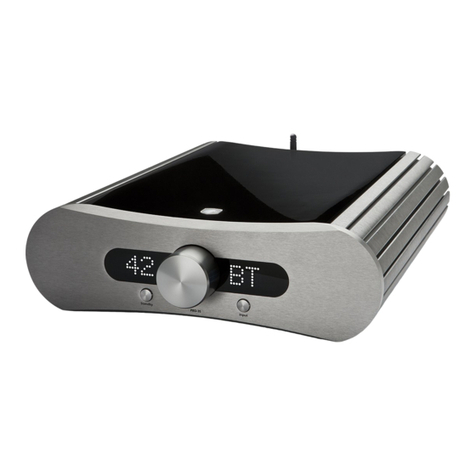
Gato Audio
Gato Audio PRD-3S user manual
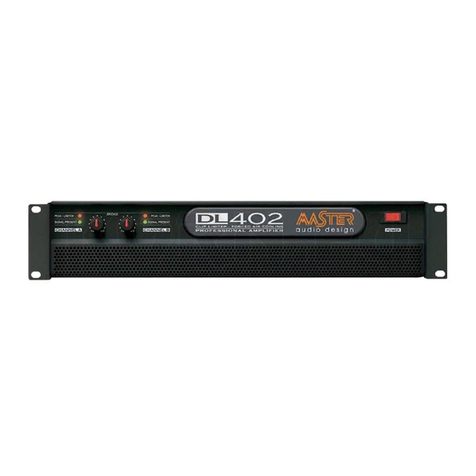
Master audio
Master audio DL Series manual

Audio Research
Audio Research D400MKII owner's manual

Cary Audio Design
Cary Audio Design SLA-80 operating manual

Harman Kardon
Harman Kardon HK503 owner's manual
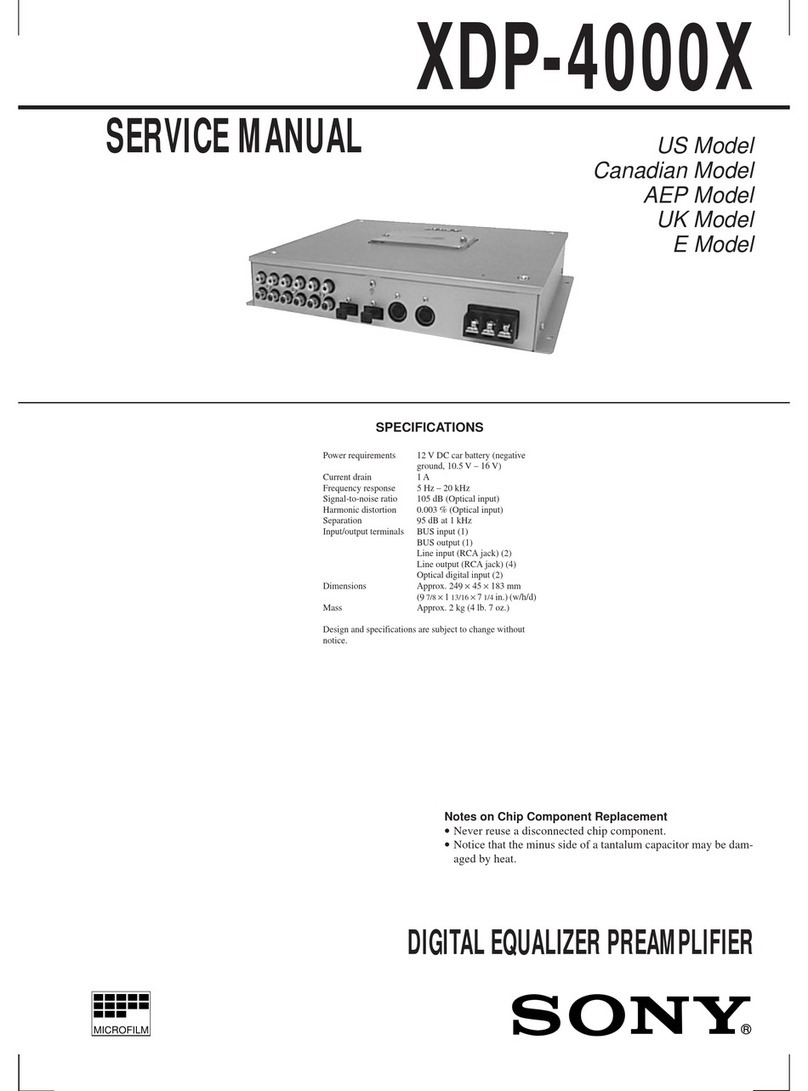
Sony
Sony XDP-4000X Operating Instructions (primary... Service manual

